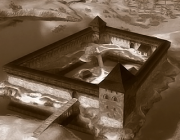Kreva in the chronicles of the First World War
Air fights and Female Death Battalion
1915 - 1918
Early autumn 1915 the war came to the lands of Kreva. There were heavy battles around Kreva and Smorgon ten days long. The German troops began a breakthrough by Sventiani, but the Russian army managed to stop them. Almost two next years the front line passed through Kreva. The town and elevations to the north-west of it were occupied by the Germans and the Russians built their military fortifications on the south-east.
Prior to the German arrival the local residents were forced to get away. The town was completely burnt, only few stone buildings remained: castle, two churches and synagogue. Each of them turned into a military object. Neutral territory on both sides of the river Krevlianka was fenced by barbed wire. The enemies tried to kick each other out of their positions, but their efforts had no results – the front line remained on its original position.
Military chronicles correspond us the events of those time. For example, it’s known out of these about the attack of the Germans near Novosiolki. On March 31th 1916 the Germans decided to strike the positions of Russian opponents. They dug underground tunnels near the village of Novosiolki which they filled with mines. The Russians understood the plans of the Germans and created countermine galleries and with two underground explosions they stopped the advance of the enemy miners. After one and a half month the Germans began to dig mine tunnels near to Novosiolki again. This time the Russians tracked them down again and started digging their counter tunnels. On the night on May 16th with the huge explosion the Russians destroyed German underground tunnels again.
Tough fights lasted during the summer 1916. In June the Germans tried to cross the river Krevlianka on south of Kreva, but the Russians met them with fire. The enemies could not continue to move forward and retreated. Later near Kreva the opponents exchanged a series of gas attacks. The Russians used gas for the first time on the Russian-German front. The Germans used gas much more often and these attacks resulted many victims.
Heroic pilots and downed planes
On 25th of September 1916 a serious air battle broke out in the skies over Kreva. Fighter planes and two mighty bombers “Ilia Muromets” were going to make a raid on the village of Boruni, where important strategic sites of the Germans were situated. The first air strike was made by «Ilia Muromets Kievski» under command of Colonel Iosif Bashko. When its task was accomplished, «Ilia Muromets XVI» rose into the sky. Pilots Dmitri Maksheev, Oleg Karpov, Farukh Gaibov and Mitrofan Rakhmin had to complete the raid begun by Baschko. But the Russian bomber was attacked by four enemy fighters. The crew members of the bomber fired machine guns and managed to shoot down three German planes. However, «Ilya Muromets» was also shoot down and all the crew members were killed. The Germans were impressed by the bravery of the Russian warriors and they buried the pilots with military honour.
The military pilot Alexei Tumansky tells about another air battle over Kreva in spring of 1917. Tumansky with the observer Optovtsev on «Forman-27» plane photographed enemy positions in the Bogushi-Kreva sector. They noticed a German plane that was moving towards them. Russian aviators let him to fly closer, flanked the enemy plane behind and shot down the fighter with the first burst of machine gun. The German plane swooped down and stuck its nose into the ground behind the cemetery of Kreva. Russian pilots continued their scouting like it never happened.
The war dragged on, battles and skirmishes changed with quite periods. Day by day soldiers were unhappier with the difficult conditions and poor supply.
The female battalion held its first fight near Kreva
After the February Revolution the soldiers oftener disobeyed commanders and deserted. Soldiers fraternization from the warring armies became common. A bolshevik named Oganesov organized one of the first fraternisations of that kind in June 1917 under Kreva.
In summer 1917 the Russian command decided to begin the breakthrough of the front line near Kreva. Huge manpower quantities and artillery of various calibres were concentrated here. At the front line arrived several air units. From the main railway a narrow gauge was laid to deliver artillery and ammunition direct to the positions. But the enemy also didn’t doze and strengthened his position too.
The command of the Western Front planned to conduct the operation in three stages: preliminary bombardment, attack and fortification period. Preliminary bombardment began on 19th of July at 05:00 and lasted three days. It was successful: enemy trenches and fortifications were damaged, barrage passages were penetrated and German cannons were destroyed.
The attack begun on 22th of July. Shortly after the beginning the Russians occupied the first line of German trenches, and In some places they managed to go even further. Despite the initial success the offensive strength began to subside soon and the attack stopped. The actions of individual units were inconsistent and there were the panic rumours about the retreat. As the result the Russians returned to their old positions and the front line remained unchanged. Nevertheless, they managed to do the unthinkable near Kreva – on this stretch of the Western Front the Russian army partly destroyed the strong fortification line of the opponent.
This battle baptized the first female military team of death, which was created by the Russian government shortly before the offensive. The battalion of Maria Bochkareva fought in the 525th Infantry Regiment of the 132nd Division of the 1st Siberian Corps. The battalion had an order: to strike at the central section of the breakthrough – from Novospassk to the northern outskirts of Kreva.
Unauthorized truce
One more symbolic event occurred during the First World War near Kreva. It happened on 26th of November 1917 – fraternisation at a higher level which had a real outcome. On that day representatives of the Russian 69th Infantry Division of the 10th Army agreed with the command of the German 11th Division to cease fire on their sector of the front line. And they succeeded. While the politicians were deciding how to complete the military operations with more profit, the military stopped to fight without any conditions.
Until now we can find on old battle fields few half-ruined German fortifications, traces of narrow-gauge railways, overgrown trenches and funnels from shells. Military graves near Kreva also remind of the First World War.







